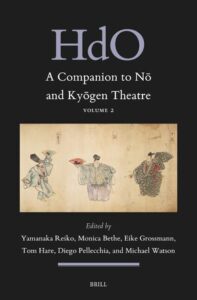能・狂言必携(全2巻)A Companion to Nō and Kyōgen Theatre
英語による能研究書の決定版、二巻本にてBrillから刊行!

Brill -NL-
Editors: 山中玲子(法政大学 能楽研究所), Monica Bethe(中世日本研究所), Eike Grossmann(ハンブルク大学), Tom Hare(プリンストン大学), Diego Pellecchia(京都産業大学), and Michael Watson(明治学院大学)
2024年12月刊行 全2巻 約900頁、図版250点以上
Vol.1 ISBN 9789004539662 EUR164.00
Web販売価格 ¥31,750(税込) / 標準価格 ¥39,688(税込)
Vol.2 ISBN 9789004722736 EUR165.00
Web販売価格 ¥31,944(税込) / 標準価格 ¥39,930(税込)
*2025年3月25日時点の価格です。実際の価格は、為替レートや出版社の都合により変動いたしますので、最新の価格は以下オンラインストアリンクをご参照ください。
*Web販売価格は、紀伊國屋書店BookWeb Proでご注文され、付帯作業を伴わない納品を行い、弊社標準書式による請求書を発行し遅滞なくお支払いただく場合、あるいは、クレジットカードでお支払いいただく場合に適用される販売価格です。
*本書は、E-Book(PDF)も提供されております。お見積り、詳細は弊社までお問合せください。
概要
中世より現代まで途絶えることなく引き継がれてきた舞台芸術として、世界でも最も古い芸能の一つである能と狂言は、日本の芸術、文化、社会、歴史に深く結びついています。
本書は、日本および海外出身の研究者たちによって執筆された解説90篇以上を全2巻に収録し、能の歴史と現在を様々な角度から見晴らす最も新しく、最も野心的なレファレンスです。収録された図版は250点以上。研究者にはもちろん、能・狂言の愛好家にも必携の書として、大学図書館、公共図書館にお備え下さい。
価格照会・ご購入
第1巻
- 紀伊國屋書店でご購入(一般の方向け):紀伊國屋書店ウェブストア
- 紀伊國屋書店でご購入(法人の方向け):紀伊國屋書店BookWeb Pro
第2巻
- 紀伊國屋書店でご購入(一般の方向け):紀伊國屋書店ウェブストア
- 紀伊國屋書店でご購入(法人の方向け):紀伊國屋書店BookWeb Pro
※本件についてのお問い合わせ、お見積りについては、最寄りの紀伊國屋書店営業所もしくはこちらのお問い合わせフォームまでご連絡ください。
収録内容明細
Volume 1
Introducing Nō and Kyōgen Tom Hare and Yamanaka Reiko
1 The History of Nō
1.1 The Origins of Nō, Sangaku, and Sarugaku until the Fourteenth Century ( Eike Grossmann and Miyamoto Keizō)
1.2 The Emergence of “Nō” and the Formation of Performers’ Organizations during the Fourteenth and Fifteenth Centuries ( Eike Grossmann and Miyamoto Keizō)
1.3 Nō in Kyoto and Its Dispersion during the Fifteenth and Sixteenth Centuries ( Eike Grossmann and Miyamoto Keizō)
1.4 Nō in the Age of Exploration ( Patrick Schwemmer)
1.5 Nō and Political Leaders from the Late Sixteenth to the Early Eighteenth Century ( Eike Grossmann and Miyamoto Keizō)
1.6 Nō Practices and Nō Culture during the Seventeenth and Eighteenth Centuries ( Eike Grossmann and Miyamoto Keizō)
1.7 The Reorganization and Standardization of Nō Practices during the Eighteenth and Nineteenth Centuries ( Eike Grossmann and Miyamoto Keizō)
1.8 The Crisis of Nō at the End of the Nineteenth and the Early Twentieth Centuries ( Eike Grossmann and Miyamoto Keizō)
1.9 Nō from World War I until the 1980s ( Eike Grossmann and Miyamoto Keizō)
References
2 Nō Performance Edited by Monica Bethe and Diego Pellecchia
2.1 Fundamentals of Nō Performance ( Monica Bethe)
2.2 The Stage ( Monica Bethe, Yamanaka Reiko, and Diego Pellecchia)
2.3 Performance Conventions ( Monica Bethe)
2.4 Movement ( Monica Bethe with Diego Pellecchia)
2.5 Music ( Takakuwa Izumi with Monica Bethe)
2.6 The History of Nō Chant ( Takakuwa Izumi with Monica Bethe)
2.7 Shōdan: the Building Blocks of Nō ( Monica Bethe and Takakuwa Izumi)
2.8 Masks ( Monica Bethe)
2.9 Costumes ( Monica Bethe)
2.10 Nō Fans ( Diego Pellecchia)
2.11 Properties ( Monica Bethe)
2.12 Interpreting Conventions for Standard and Variant Performances ( Yamanaka Reiko)
2.13 Underlying Principles of Nō Dramaturgy ( Monica Bethe)
References
3 Training, Practice, and Production Edited by Diego Pellecchia and Yamanaka Reiko
3.1 Introduction ( Diego Pellecchia and Yamanaka Reiko)
3.2 Training ( Diego Pellecchia and Yamanaka Reiko)
3.3 Female Performers in Nō ( Barbara Geilhorn)
3.4 Practice and Production ( Diego Pellecchia and Yamanaka Reiko)
3.5 The Role of Amateur Practitioners ( Diego Pellecchia and Yamanaka Reiko)
3.6 Kurokawa Nō ( Eike Grossmann)
3.7 Recent Developments and Future Perspectives ( Diego Pellecchia and Yamanaka Reiko)
References
4 Plays: Their Conventions and Backgrounds Edited by Tom Hare, Takeuchi Akiko, Michael Watson, and Yamanaka Reiko
4.1 Introduction ( Takeuchi Akiko)
4.2 Categories of Nō Plays ( Yamanaka Reiko)
4.3 Sources of Nō Plays ( Takeuchi Akiko)
4.4 Nō and Its Belief Systems ( Tom Hare and Takahashi Yūsuke)
4.5 Reading Nō: Mugen nō and Genzai nō ( Monogurui nō) ( Yamanaka Reiko)
4.6 Aspects of Time and Character Relations ( Paul S. Atkins)
4.7 Stylistics and Poetics ( Takeuchi Akiko)
4.8 Narration and Ambiguous Voice ( Takeuchi Akiko)
4.9 Religious and Political Allegory in Nō ( Susan Blakeley Klein)
4.10 Medieval Commentaries and Nō Theatre ( Susan Blakeley Klein)
4.11 Bangai kyoku and Shinsaku nō: Noncanonical Plays and Modern Nō Plays ( Fukazawa Nozomi and Takeuchi Akiko)
4.12 Conclusion ( Takeuchi Akiko)
4.13 Excursus: Dramaturgy in Nō and Greek Tragedy ( Mae J. Smethurst)
References
5 Authors Edited by Tom Hare and Yamanaka Reiko
5.1 Introduction ( Tom Hare and Yamanaka Reiko)
5.2 Kan’ami ( Tom Hare and Yamanaka Reiko)
5.3 Zeami ( Tom Hare and Yamanaka Reiko)
5.4 Motomasa ( Tom Hare and Yamanaka Reiko)
5.5 Zenchiku ( Tom Hare and Takahashi Yūsuke)
5.6 Nobumitsu ( Ikai Takamitsu and Lim Beng Choo)
5.7 Nagatoshi ( Ikai Takamitsu and Lim Beng Choo)
5.8 Zenpō ( Ikai Takamitsu and Lim Beng Choo)
5.9 Miyamasu ( Ikai Takamitsu and Lim Beng Choo)
5.10 Amateurs ( Ikai Takamitsu and Lim Beng Choo)
References
Contents of Volume 2
6 Treatises and Criticism Edited by Tamamura Kyō and Shelley Fenno Quinn
6.1 Introduction ( Tamamura Kyō)
6.2 Zeami’s Treatises: an Overview ( Shelley Fenno Quinn)
6.3 Zeami as Philosopher: Who Makes the Flower Bloom? ( Tamamura Kyō)
6.4 Zenchiku’s Treatises and Criticism ( Takahashi Yūsuke)
6.5 Konparu Zenpō’s Treatises and Criticism ( Ikai Takamitsu)
6.6 Nō Treatises from the Late Muromachi to Edo Periods ( Miyamoto Keizō)
6.7 Modern Theories of Nō ( Yokoyama Tarō)
References
7 Material Culture of Nō and Kyōgen Edited by Eike Grossmann
7.1 Introduction ( Eike Grossmann)
7.2 The Production of Costumes, Masks, and Fans ( Monica Bethe)
7.3 The Transmission of Masks: Carvers and Their Lineages ( Adam Zollinger)
7.4 Instruments: Artistic Value and Development of Their Forms ( Takakuwa Izumi)
7.5 Performance Spaces: History and Materiality of the Nō Stage ( Miyamoto Keizō)
7.6 Tsuke: Notes on Movements, Gestures, Music, and Stage Properties ( Fukazawa Nozomi, Nakatsuka Yukiko, and Yamanaka Reiko)
7.7 Utaibon for Amateurs and Connoisseurs ( Ikai Takamitsu)
7.8 Nō and Kyōgen Illustrations ( Monica Bethe)
7.9 Nō and Kyōgen Prints and Paintings in Modern Japan ( Richard Smethurst)
7.10 Nō Culture in Everyday Life: Koutaibon, Sugoroku, Karuta, Yubimen, Netsuke, and Nō Ningyō ( Eike Grossmann)
References
8 Reception Edited by Diego Pellecchia and Yokoyama Tarō
8.1 Introduction ( Yokoyama Tarō)
8.2 Reception of Nō in the Late Nineteenth and Early Twentieth Centuries ( Diego Pellecchia)
8.3 Nō and Modernism ( Diego Pellecchia and Takeuchi Akiko)
8.4 Nōgaku and Film ( Kodama Ryūichi)
8.5 Nō and Contemporary Theatre Abroad and in Japan ( Diego Pellecchia and Yokoyama Tarō)
8.6 Why Not Nō? ( Reginald Jackson and Yokoyama Tarō)
8.7 Nōgaku and Kabuki ( Kodama Ryūichi)
References
9 Kyōgen Edited by Monica Bethe
9.1 Introduction ( Monica Bethe)
9.2 Plays, Plots, and Role Types ( Jonah Salz)
9.3 Dramaturgy ( Jonah Salz)
9.4 Costumes and Masks ( Monica Bethe)
9.5 Organization, Training, and Creativity ( Jonah Salz)
9.6 History ( Monica Bethe)
9.7 The Evolution of Texts ( Taguchi Kazuo)
9.8 Discourses ( Taguchi Kazuo)
9.9 Sagi kyōgen ( Alex Rogals)
9.10 Women in Kyōgen ( Barbara Geilhorn)
9.11 Inspiration, Fusion, and Form: Kyōgen outside Japan ( Ondřej Hýbl)
References
10 Research Overview Edited by Yamanaka Reiko, Tom Hare, and Michael Watson
10.1 Introduction ( Yamanaka Reiko)
10.2 Research into Nō before the Meiji Period ( Yamanaka Reiko)
10.3 Nō Scholarship from the Meiji, Taishō, and Shōwa Periods to World War II ( Tom Hare and Yamanaka Reiko)
10.4 Postwar Studies of Nō ( Yamanaka Reiko)
10.5 The History of Nō Research and Translations in Western Languages: French, Italian, German, and English ( Diego Pellecchia, Eike Grossmann, and Tom Hare)
References
11 Appendices
11.1 Finding List for Nō Texts ( Michael Watson)
11.2 Summaries of Nō Plays ( Nakatsuka Yukiko and Michael Watson, with contributions by Fukazawa Nozomi, Inoue Megumi, Hana Lethen, Pia Schmitt, Patrick Schwemmer, and Tomiyama Takahiro)
11.3 Summaries of Kyōgen Plays ( Monica Bethe)
References ( Michael Watson)
Glossary
Index
(紀伊國屋書店 学術洋書部)





